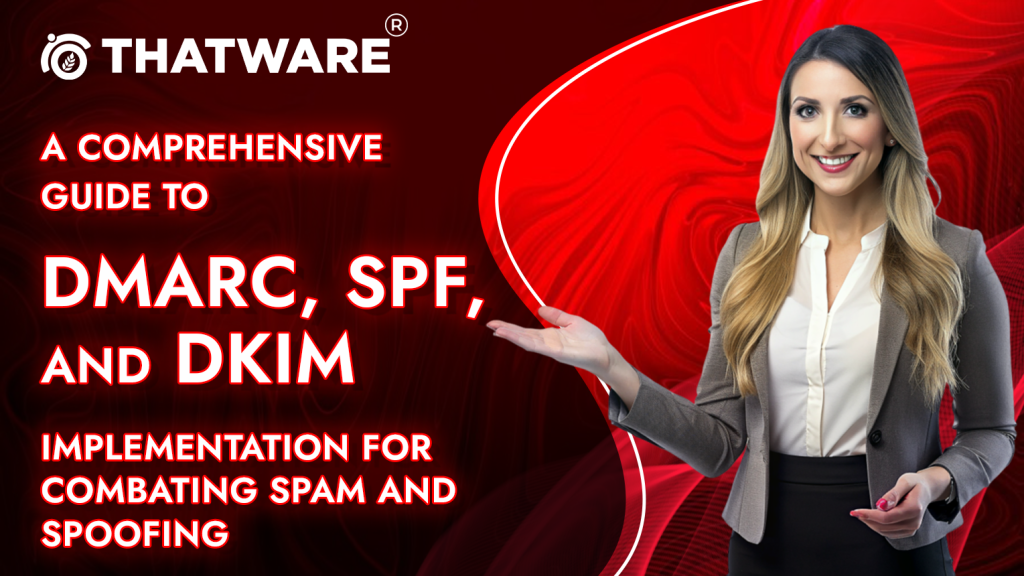GET A FREE CUSTOMIZED SEO AUDIT & DIGITAL MARKETING STRATEGY FOR YOUR BUSINESS
⭐️Overview of the Importance of Email Security
In today’s digital age, email is a vital communication tool for individuals and organizations alike. However, it’s also a prime target for cybercriminals, with 60% of businesses experiencing a phishing attack in 2020 alone. Email security isn’t just about keeping unwanted messages at bay; it’s about safeguarding sensitive information from malicious intents like fraud, identity theft, and data breaches. A single email breach can result in financial losses averaging over $3.86 million, not to mention the lasting damage to an organization’s reputation.

⭐️Brief Introduction to DMARC, SPF, and DKIM
To combat these threats, three key email authentication protocols have emerged as the gold standard: DMARC, SPF, and DKIM. Each plays a crucial role in verifying the authenticity of an email, thus protecting against spam, phishing, and other email-based attacks.
⭐️DMARC (Domain-based Message Authentication, Reporting, and Conformance)
DMARC ensures that an email is authenticated against both the SPF and DKIM standards, and that it aligns with the sender’s stated policies. By enabling domain owners to specify how their email should be handled if it fails these checks, DMARC provides a powerful tool for preventing email fraud. Furthermore, it offers visibility into email flow, allowing senders to track and prevent unauthorized use of their domain.
⭐️SPF (Sender Policy Framework)
SPF allows domain owners to define which mail servers are authorized to send email on their behalf. When an email is received, the receiving server checks the SPF record in the DNS to verify the sender’s legitimacy. This helps prevent spammers from forging the “From” address, a common tactic in phishing scams.
⭐️DKIM (DomainKeys Identified Mail)
DKIM adds a digital signature to each outgoing email, linked to the sender’s domain. This signature is verified against a public cryptographic key in the domain’s DNS records. By confirming that the email content hasn’t been tampered with in transit, DKIM provides an additional layer of trust, ensuring that the received message is genuine and unaltered.
Implementing DMARC, SPF, and DKIM is not just a technical necessity; it’s a strategic imperative for any organization that values the integrity and confidentiality of its email communications. By leveraging these protocols, businesses can significantly reduce the risk of email-based threats, safeguarding their information assets and reinforcing their reputation as a trustworthy entity in the digital ecosystem.
⭐️Understanding Email Authentication Methods
Email authentication is the cornerstone of secure electronic communication, acting as the gatekeeper that separates legitimate correspondence from potentially harmful content. It’s a set of protocols designed to verify the identity of the sender and the integrity of the message. This verification process helps to prevent malicious activities such as phishing, spoofing, and spam, which are not only nuisances but also serious security threats.
⭐️The Role of DMARC, SPF, and DKIM in Email Security
The triad of DMARC, SPF, and DKIM forms the backbone of modern email authentication and security. These protocols work in tandem to verify the authenticity of the sender and the integrity of the message, providing a multi-layered defense against common email threats.
SPF (Sender Policy Framework) checks whether the sending server’s IP address is authorized by the domain’s DNS record to send emails. This is crucial because, according to a report by the FBI, there were over 241,000 incidents of business email compromise (BEC) in 2020, leading to losses exceeding $1.8 billion. SPF helps reduce these incidents by verifying the sender’s IP address, making it harder for attackers to impersonate a trusted domain.
DKIM (DomainKeys Identified Mail) adds an encrypted signature to the header of each outgoing email, which can be verified using a public key in the sender’s DNS record. This signature ensures that the content of the email remains unaltered in transit, thereby maintaining its integrity. A study by Valimail found that implementing DKIM can increase email deliverability rates by up to 10%, as it builds trust with email service providers by proving the email has not been tampered with.
DMARC (Domain-based Message Authentication, Reporting, and Conformance) builds upon SPF and DKIM. It allows domain owners to define how receiving email servers should treat emails that fail SPF and DKIM checks. More importantly, it provides feedback on these checks, enabling organizations to monitor and protect their email domains actively. With DMARC, businesses can improve their email deliverability by up to 30%, as reported by the Global Cyber Alliance.
⭐️SPF Setup Guide: Ensuring the Authenticity of Your Email Sender
Sender Policy Framework (SPF) is a vital tool in the email security arsenal, designed to verify that the sender of an email has the authority to use the domain from which it originates. In an era where email-based threats are increasingly sophisticated, implementing SPF is more than a technical task; it’s a strategic necessity to protect your organization’s communications integrity.
⭐️What is SPF and How it Works
SPF allows domain owners to define which mail servers are authorized to send emails on behalf of their domain. This is done by creating a DNS TXT record that lists the IP addresses of the servers permitted to send email for that domain. When an email is received, the recipient’s server checks this SPF record to verify that the email comes from a server authorized by the domain’s administrator.
⭐️Step-by-step guide to setting up SPF
Step 1: Login to the Domain Settings and choose the Mail Id on which the Protocols are to be implemented.
In our case, we use Godaddy and we choose the following mail:
Step 2: Go to the Domains DNS Settings and keep it opened.
Step 3: Now we need a SPF Record Generator. Use the following link
https://easydmarc.com/tools/spf-record-generator?domain=thatware.online
Step 4: Enter the following fields as below:
Domain: Enter domain name. Rest all is same.
The Records are generated as below:
Step 5:
Add the new Record in the DNS Section
Step 6: Now we need to validate the implementation of SPF on the Mail Server. Go to https://mxtoolbox.com/spf.aspx
Enter the Domain name and hit enter. If the following result appears then SPF is implemented properly.
⭐️DKIM Configuration: Strengthening Email Integrity and Trust
DomainKeys Identified Mail (DKIM) is an essential component of a comprehensive email security strategy, serving as a robust method to validate the authenticity and integrity of email messages. In the ever-evolving landscape of cyber threats, DKIM plays a pivotal role in fortifying an organization’s defense against email-based attacks, particularly those involving message tampering and identity fraud.
⭐️Explaining DKIM and Its Role in Email Security
DKIM provides a mechanism for email senders to add a digital signature to their messages. This signature is linked to the domain of the sender, allowing recipient servers to verify that the email was indeed sent from the claimed domain and that its content has not been altered during transit.
⭐️Step-by-step guide to setting up SPF
Step 1: Login to the Domain Settings and choose the Mail Id on which the Protocols are to be implemented.
In our case, we use Godaddy and we choose the following mail:
Step 2: Go to the Domains DNS Settings and keep it opened.
Step 3: Now we need generate the DKIM Key. Use the following tool
Step 4: Use the following values and hit generate. Except the domain name, all values will be the same.
In the selector field you may select “s1” or “s2”
Step 5: Now go to the Domain DNS Setting and add the TXT Record in the format given below and hit save.
Step 6: Now we need to validate the Fix. Go to the link
https://mxtoolbox.com/dkim.aspx
Hit enter and if the following result appears, your DKIM is validated.
⭐️DMARC Implementation: Enhancing Email Security and Domain Reputation
Domain-based Message Authentication, Reporting, and Conformance (DMARC) is a powerful protocol that builds on the foundation laid by SPF and DKIM. It not only authenticates the source of an email but also instructs receiving servers on how to handle messages that fail authentication checks. As cyber threats evolve, DMARC has become indispensable for organizations looking to protect their domain from abuse and enhance their email deliverability.
⭐️Detailed Explanation of DMARC and Its Benefits
DMARC allows domain owners to publish policies in their DNS records that define their email authentication practices and how receiving servers should respond to emails that fail SPF and DKIM checks. These policies ensure that only authorized emails representing the domain reach the recipient, significantly reducing the risk of phishing and spoofing attacks.
⭐️The benefits of DMARC implementation are substantial:
- Prevention of Email Fraud: By enforcing strict authentication, DMARC significantly reduces unauthorized use of your domain for sending fraudulent emails. This is critical, given that 96% of phishing attacks arrive by email, according to Verizon’s Data Breach Investigations Report.
- Improved Deliverability: Emails from domains with DMARC are more likely to be trusted by email providers, improving deliverability rates. A study by Valimail shows that DMARC can increase email deliverability by up to 10-15%, a significant margin that can translate into better engagement rates and communication effectiveness.
- Enhanced Visibility and Control: DMARC provides insights through reporting on who is sending email on behalf of your domain, allowing you to identify and address unauthorized email flows. This level of control and visibility is crucial in a landscape where, according to the Anti-Phishing Working Group, phishing attacks have been steadily increasing, reaching an all-time high in recent years.
- Protection of User Trust and Brand Reputation: By securing your email domain against impersonation, DMARC helps maintain the trust your users and partners place in your communications. This trust is vital for business integrity and continuity, especially considering that a single successful phishing attack can cost a company over $1.6 million on average, as reported by IBM’s Cost of a Data Breach Study.
Implementing DMARC involves defining a policy that specifies whether the receiving server should reject, quarantine, or allow emails that fail SPF and DKIM checks. This policy is published in the DNS alongside the SPF and DKIM records, creating a robust authentication triad that fortifies your email ecosystem against threats.
⭐️Step-by-step guide to setting up DMARC
Step 1: Login to the Domain Settings and choose the Mail Id on which the Protocols are to be implemented.
In our case, we use Godaddy and we choose the following mail:
Step 2: Go to the Domains DNS Settings and keep it opened.
Step 3: Now we need to generate your DMARC Value Key. Go to the following url:
https://easydmarc.com/tools/dkim-record-generator
Step 4: Enter the values as follows. Except the domain name, rest values will remain the same.
The Records generated are as below:
Step 5: Now go to the Domain DNS Setting and add the TXT Record in the format given below and hit save.
Step 6: Now we need to validate the records.
Go to https://mxtoolbox.com/dmarc.aspx
Enter the domain name and hit enter. If the following result appears. Then everything is perfect.
⭐️Combating Email Spam: Leveraging SPF, DKIM, and DMARC for a Cleaner Inbox
Email spam remains one of the most pervasive challenges in digital communication, with The Radicati Group reporting that spam messages accounted for 45% of all email traffic in 2021. Beyond being an annoyance, spam can serve as a vehicle for more serious threats, such as malware and phishing. However, implementing SPF, DKIM, and DMARC can be a game-changer in the fight against unwanted email.
⭐️Strategies to Reduce Spam Using SPF, DKIM, and DMARC
The combination of SPF, DKIM, and DMARC provides a formidable defense against spam. Here’s how these protocols contribute to spam reduction:
- SPF (Sender Policy Framework): By verifying that incoming emails originate from a server listed in the domain’s SPF record, SPF helps filter out emails that try to spoof your domain. This direct approach significantly reduces the volume of spam and phishing attempts that can use your domain as a disguise.
- DKIM (DomainKeys Identified Mail): DKIM’s role in fighting spam comes from its ability to ensure the integrity of the message content. A valid DKIM signature indicates that the message has not been altered in transit, thus maintaining its authenticity. This helps email service providers (ESPs) to better sort legitimate emails from spam.
- DMARC (Domain-based Message Authentication, Reporting, and Conformance): DMARC takes the fight against spam a step further by providing a clear policy on how to handle emails that fail SPF and DKIM checks. By instructing ESPs to reject or quarantine these failures, DMARC minimizes the chances of spam reaching the user’s inbox.
⭐️Tools and Techniques for Spam Prevention
In addition to implementing SPF, DKIM, and DMARC, there are several tools and techniques that organizations can use to bolster their spam prevention efforts:
- Email Filtering Solutions: Advanced email filtering solutions use algorithms and machine learning to detect and block spam emails before they reach the user’s inbox. These tools can be integrated with existing email systems to provide an additional layer of defense.
- Regular Audits and Monitoring: Conducting regular audits of your email authentication setup and monitoring the reports generated by DMARC can help identify potential vulnerabilities and sources of spam.
- User Education and Training: Educating employees about the dangers of spam and teaching them how to recognize suspicious emails can significantly reduce the risk of successful spam and phishing attacks.
- Blacklists and Whitelists: Utilizing blacklists to block known spam sources and whitelists to allow emails from trusted senders can further refine email filtering efforts.
⭐️Final Thoughts
The alarming statistics of email-related threats underscore the urgency of adopting these authentication standards. With billions of emails sent daily, the potential for spam, phishing, and other malicious activities is vast. However, the adoption of SPF, DKIM, and DMARC offers a beacon of hope, significantly reducing these risks and fortifying the trustworthiness of email communication.
Incorporating these protocols into your email security strategy is a proactive step towards building a resilient digital defense mechanism. Beyond the technical setup, it’s about creating a culture of security awareness within your organization. Regular monitoring, updating, and educating employees about the evolving landscape of cyber threats are essential to maintain and enhance your security posture.
As we look to the future, the role of AI and machine learning in combating email threats is set to increase, offering even more sophisticated tools to detect and neutralize advanced threats. Yet, the foundation of email security will continue to rest on the pillars of SPF, DKIM, and DMARC. These protocols not only protect against immediate threats but also prepare organizations to adapt to the evolving tactics of cyber adversaries.

Thatware | Founder & CEO
Tuhin is recognized across the globe for his vision to revolutionize digital transformation industry with the help of cutting-edge technology. He won bronze for India at the Stevie Awards USA as well as winning the India Business Awards, India Technology Award, Top 100 influential tech leaders from Analytics Insights, Clutch Global Front runner in digital marketing, founder of the fastest growing company in Asia by The CEO Magazine and is a TEDx speaker.



